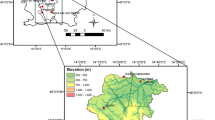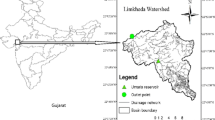Abstract
Quantifying the potential impacts of changing land use/cover in watersheds especially via the rainfall-runoff modeling remains among the more challenging problems in hydrology. This study presents a new method in detection, quantification and prediction of long term land use/cover change of the South Fork Eel River watershed, based on linear conceptual rainfall-runoff modeling and computational intelligence tools. The methodology was presented via a two-phase modeling procedure: event-based and continuous-based modeling phases. In the first phase, a linear conceptual rainfall-runoff model was proposed based on unequal cascade of reservoirs in which the drainage basin was divided into several sub-basins in a sequence based on the stream gauge locations and drainage network. This model includes two parameters of linear reservoir and channel lag times which were computed using relations based on the watershed’s geomorphology. The parameters were calibrated using observed rainfall-runoff events via genetic algorithm. In the second phase, calibrated lag times of events during each month were averaged to produce monthly time series of lag time to be used for training of classic artificial neural network and hybrid Wavelet-ANN for prediction of land use/cover change effect on the watershed’s response in generating runoff. Results indicate the good capability of such two-phase modeling procedure in quantification and prediction of land use change effects on hydrological response of the watershed. Results show, autoregressive and seasonal patterns of lag time, evapotranspiration and temperature are the most important factors which could affect rainfall-runoff modeling of the watershed. The land use change effect results show a slight improvement in the vegetation cover during long period for the South Fork Eel River watershed.






Similar content being viewed by others
References
Abbott MB, Bathurst JC, Cunge JA, O’Connell PE, Rasmussen J (1986) An introduction to the European hydrological system-system hydrologique European, SHE. 1. History and philosophy of a physically-based, distributed modelling system. J Hydrol 87:45–59
Abrahart RJ, Anctil F, Coulibaly P, Dawson CW, Elshorbagy A, Mount NJ, See LM, Shamseldin AY, Solomatine DP, Toth E, Wilby RL (2012) Two decades of anarchy? Emerging themes and outstanding challenges for neural network river forecasting. Prog Phys Geogr 36(4):480–513
Agirre U, Goñi M, López JJ, Gimena FN (2005) Application of a unit hydrograph based on sub-watershed division and comparison with Nash’s instantaneous unit hydrograph. Catena 64:321–332
ASCE Task Committee on Application of Artificial Neural Networks in Hydrology (2000) Artificial neural networks in hydrology II: hydrologic applications. J Hydrol Eng 5:124–137
Beven KJ (2001) Rainfall-runoff modelling, the primer. Wiley, Chichester
Beven KJ, Binley AM (1992) The future of distributed models: model calibration and uncertainty prediction. Hydrol Process 6(3):279–298
Bravo SCA, Harley BM, Perkins FE, Eagleson PS (1970) A linear distributed model of catchment model. Hydrodynamics Laboratory Report No.123. Massachusetts Institute of Technology, Cambridge
California Climate Data Archive (2011) http://www.calclim.dri.edu/pages/networks.html, Accessed 15 May 2011
California Data Exchange Center (2011) http://cdec.water.ca.gov, Accessed 12 May 2011
Chau KW (2008) Application of a particle swarm optimization algorithm to hydrological problems. In: Robinson LN (ed) Water resources research progress. Nova Science Publishers, New York, pp 3–12
Cheng CT, Chau KW, Sun YG, Lin JY (2005) Long-term prediction of discharges in Manwan Reservoir using artificial neural network models. Lect Notes Comput Sci 3498:1040–1045
Chow VT, Maidment DR, Mays LW (1988) Applied hydrology. McGraw-Hill, New York
Cooper VA, Nguyen VTV, Nicell JA (1997) Evaluation of global optimization methods for conceptual rainfall-runoff model calibration. Water Sci Technol 36(5):53–60
Dooge JCI (1959) A general theory of the unit hydrograph. J Geophys Res 64(2):241–256
Duan Q, Gupta VK, Sorooshian S (1992) Effective and efficient global optimization for conceptual rainfall–runoff models. Water Resour Res 28(4):1015–1031
Eeles CWO, Blackie JR (1993) Land-use changes in the Balquidder catchments simulated by a daily streamflow model. J Hydrol 145:315–336
Franchini M, Galeati G (1997) Comparing several genetic algorithm schemes for the calibration of conceptual rainfall—runoff models. Hydrol Sci J 42(3):357–379
Guo J, Zhou J, Song L, Zou Q, Zeng X (2012) Uncertainty assessment and optimization of hydrological model with shuffled complex evolution metropolis algorithm: an application to artificial neural network rainfall-runoff model. Stoch Environ Res Risk Assess 27(4):985–1004
Im S, Kim H, Kim C, Jang C (2009) Assessing the impacts of land use changes on watershed hydrology using MIKE SHE. Environ Geol 57(1):231–239
Isik S, Kalin L, Schoonover JE, Srivastava P, Lockaby BG (2012) Modeling effects of changing land use/cover on daily streamflow: an artificial neural network and curve number based hybrid approach. J Hydrol 485:103–112
Jakeman AJ, Littlewood IG, Whitehead PG (1990) Computation of the instantaneous unit hydrograph and identifiable component flows with application to two small upland catchments. J Hydrol 117:275–300
Kan G, Yao C, Li Q, Li Z, Yu Z, Liu Z, Ding L, He X, Liang K (2015) Improving event-based rainfall-runoff simulation using an ensemble artificial neural network based hybrid data-driven model. Stoch Environ Res Risk Assess 29(5):1345–1370
Kite G (2001) Modelling the Mekong: hydrological simulation for environmental impact studies. J Hydrol 253:1–13
Krysanova V, Hattermann F, Wechsung F (2005) Development of the ecohydrological model SWIM for regional impact studies and vulnerability assessment. Hydrol Process 19:763–783
Legates DR, McCabe GJ Jr (1999) Evaluating the use of goodness-of-fit measures in hydrologic and hydroclimatic model validation. Water Resour Res 35(1):233–241
Lin JY, Cheng CT, Chau KW (2006) Using support vector machines for long-term discharge prediction. Hydrol Sci J 51(4):599–612
Lopez JJ, Gimena FN, Goni M, Agirre U (2005) Analysis of a unit hydrograph model based on watershed geomorphology represented as a cascade of reservoirs. Agric Water Manag 77:128–143
Lopez JJ, Gimena FN, Giraldez JV, Ayuso JL, Goni M (2011) Comparative analysis of a geomorphology-based instantaneous unit hydrograph in small mountainous watersheds. Hydrol Process 26:2909–2924
Maddaus WO, Eagleson PS (1969) A distributed linear representation of surface runoff. Hydrodynamics Laboratory Report No. 115. Massachusetts Institute of Technology, Cambridge
Mallat SG (1998) A wavelet tour of signal processing, 2nd edn. Academic Press, San Diego
Math Works Incorporated (2010) MATLAB user guide. Math Works Incorporated, Natick
Mohan S, Vijayalakshmi DP (2008) Estimation of Nash’s IUH parameters using stochastic search algorithms. Hydrol Process 22:3507–3522
Nash JE (1957) The form of instantaneous unit hydrograph. IAHS Publ 45:114–121
Nash JE, Sutcliffe JV (1970) River flow forecasting through conceptual models I: a discussion of principles. J Hydrol 10(3):282–290
Niehoff D, Fritsch U, Bronstert A (2002) Land-use impacts on storm-runoff generation: scenarios of land-use change and simulation of hydrological response in a meso-scale catchment in SW-Germany. J Hydrol 267:80–93
Niu J, Sivakumar B (2013) Study of runoff response to land use change in the East River basin in South China. Stoch Environ Res Risk Assess 28(4):857–865
Nourani V (2008) A comparative study on calibration methods of Nash’s rainfall-runoff model to Ammameh watershed. Iran J Urban Environ Eng 2(1):14–20
Nourani V, Parhizkar M (2013) Conjunction of SOM-based feature extraction method and hybrid wavelet-ANN approach for rainfall-runoff modeling. J Hydroinform 15(3):829–848
Nourani V, Singh VP, Delafrouz H (2009a) Three geomorphological rainfall-runoff models based on the linear reservoir concept. Catena 76:206–214
Nourani V, Komasi M, Mano A (2009b) A multivariate ANN-wavelet approach for rainfall–runoff modeling. Water Resour Manag 23:2877–2894
Nourani V, Alami MT, Aminfar MH (2009c) A combined neural-wavelet model for prediction of Ligvanchai watershed precipitation. Eng Appl Artif Intell 16:1–12
Nourani V, Kisi Ö, Komasi M (2011) Two hybrid artificial intelligence approaches for modeling rainfall–runoff process. J Hydrol 402:41–59
Nourani V, Baghanama HA, Adamowski J, Kisi O (2014a) Applications of hybrid wavelet–artificial intelligence models in hydrology: a review. J Hydrol 517:358–377
Nourani V, Khanghah TR, Baghanam HA (2014b) Implication of feature extraction methods to improve performance of hybrid Wavelet-ANN rainfall–runoff model. In: Issac B, Israr N (eds) Case studies in intelligent computing. Taylor and Francis Publications, New York, pp 457–498
Nourani V, Fakheri Fard A, Niazi F, Gupta HV, Goodrich DC, Kamran KV (2015) Implication of remotely sensed data to incorporate land cover effect into a linear reservoir-based rainfall–runoff model. J Hydrol 529:94–105
Saeidifarzad B, Nourani V, Aalami MT, Chau KW (2014) Multi-site calibration of linear reservoir based geomorphologic rainfall-runoff models. Water 6:2690–2716
Singh VP (1988) Hydrologic systems. Rainfall-runoff modeling, vol I. Prentice-Hall, Englewood Cliffs
Taormina R, Chau KW (2015) ANN-based interval forecasting of streamflow discharges using the LUBE method and MOFIPS. Eng Appl Artif Intell 45:429–440
Torrence C, Compo GP (1998) A practical guide to wavelets analysis. Bull Am Meteor Soc 79(1):61–78
U.S. Geological Survey (2011) http://www.usgs.gov/water, Accessed 10 May 2011
Wang QJ (1991) The genetic algorithm and its application to calibrating conceptual rainfall–runoff models. Water Resour Res 27(9):2467–2471
Wang YC, Yu PS, Yang TC (2010) Comparison of genetic algorithms and shuffled complex evolution approach for calibrating distributed rainfall–runoff model. Hydrol Process 24:1015–1026
Wang Y, Guo S, Chen H, Zhou Y (2014) Comparative study of monthly inflow prediction methods for the three gorges reservoir. Stoch Environ Res Risk Assess 28(3):555–570
Wei YHD, Ye X (2014a) Urbanization, land use, and sustainable development in China. Stoch Environ Res Risk Assess 28(4):755
Wei YHD, Ye X (2014b) Urbanization, urban land expansion and environmental change in China. Stoch Environ Res Risk Assess 28(4):757–765
Yu H, Wilamowski BM (2011) Levenberg–Marquardt training. In: Wilamowski BM, Irwin JD (eds) Industrial electronics handbook, 2nd edn. CRC Press, Boca Raton
Zhang Y, Xia J, Shao Q, Zhai X (2011) Water quantity and quality simulation by improved SWAT in highly regulated Huai river basin of China. Stoch Environ Res Risk Assess 27(1):11–27
Author information
Authors and Affiliations
Corresponding author
Rights and permissions
About this article
Cite this article
Nourani, V., Saeidifarzad, B. Detection of land use/cover change effect on watershed’s response in generating runoff using computational intelligence approaches. Stoch Environ Res Risk Assess 31, 1341–1357 (2017). https://doi.org/10.1007/s00477-016-1220-z
Published:
Issue Date:
DOI: https://doi.org/10.1007/s00477-016-1220-z




